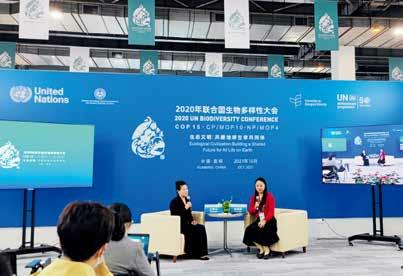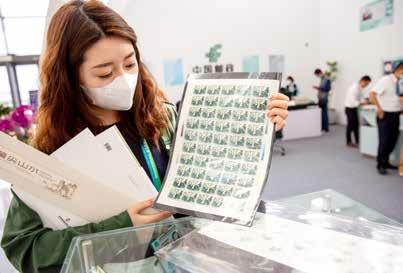Returning Nature to Cities
2021-12-09byZhouXin
by Zhou Xin

Growing public awareness for environmental protection has made “biodiversity” a household term. But what is it exactly? Many may have some vague ideas and lack deeper understanding.
On October 13, 2021, Li Weiwei, a senior engineer with the Kunming Institute of Zoology under the Chinese Academy of Sciences, sat down with China Pictorial on the sidelines of the 15th meeting of the Conference of the Parties to the United Nations Convention on Biological Diversity in Kunming City, Yunnan Province. She has much to say to help everyone understand biodiversity.
Biodiversity in Everyday Life
As a biologist and a mother of two, Li often uses simple language that children can understand to talk about topics related to biodiversity, so explaining it in ways everyone can understand is right up her alley. Li sees biodiversity not as something about deep mountains and rapid rivers, but more about everyday life. Many household goods such as tables, chairs, stools, blankets, and beddings are all made from biological resources. Pets such as cats, dogs, and rabbits, and even unwanted friends such as mosquitoes, cockroaches, and mice are all part of biodiversity. However, biodiversity conservation has varied priorities and approaches. Damage or harm caused by some species needs to be controlled. In cities, farmers markets have some of the richest biodiversity. Late Chinese scientist Yuan Longping, known as the “father of hybrid rice,” did research not only in laboratories, but also “in supermarkets and rice markets,” according to Li.
If people pay close attention, they will find biodiversity abundant in their daily life even though many city dwellers feel estranged from nature.
Environmental protection is just one aspect of biodiversity conservation. Li identifies the five major reasons for biodiversity loss as habitat fragmentation, invasion of alien species, excessive exploitation of resources, environmental pollution, and climate change. Maintaining biodiversity calls for efforts to address all of the five problems.
The Convention on Biological Diversity has three major objectives: the conservation of biological diversity, the sustainable use of its components, and the fair and equitable sharing of the benefits arising out of the utilization of genetic resources.
With scholar Yang Chunyan, Li compiled the popular science book Quick Reading on Biodiversity, which was published recently.

Biodiversity Stakeholders
As part of a wider effort to spread knowledge on biodiversity conservation, the book Quick Reading on Biodiversity covers the definition of biodiversity, the history of the Convention on Biological Diversity, everyday life related to biodiversity, things ordinary people can do to conserve biodiversity, and Chinas measures and challenges in the realm.
“I hope the book enables people to make a difference in everyday life,”says Li. “They may begin to notice biodiversity when they take their kids out for a walk or visit a grocery store.”She believes that biodiversity matters to everyone, and everyone counts in conservation efforts.
She hopes that the public become more involved in biodiversity conservation. Ordinary people can do quite a lot. They can buy greener, reject wild animal products, and reduce usage of disposable goods. They can be rational gourmets, purchase local food to protect genetic diversity, and reject food and medicine made from wild animals and plants. People can become urban farmers and put vegetable gardens on their balconies. They can also use resources more efficiently, save water, electricity, and gas as much as possible, and avoid wasting food. Travel can also be green and low-carbon.
Lis goal on biodiversity education is both poetic and down-to-earth: “I hope we can pursue returning nature to cities.”